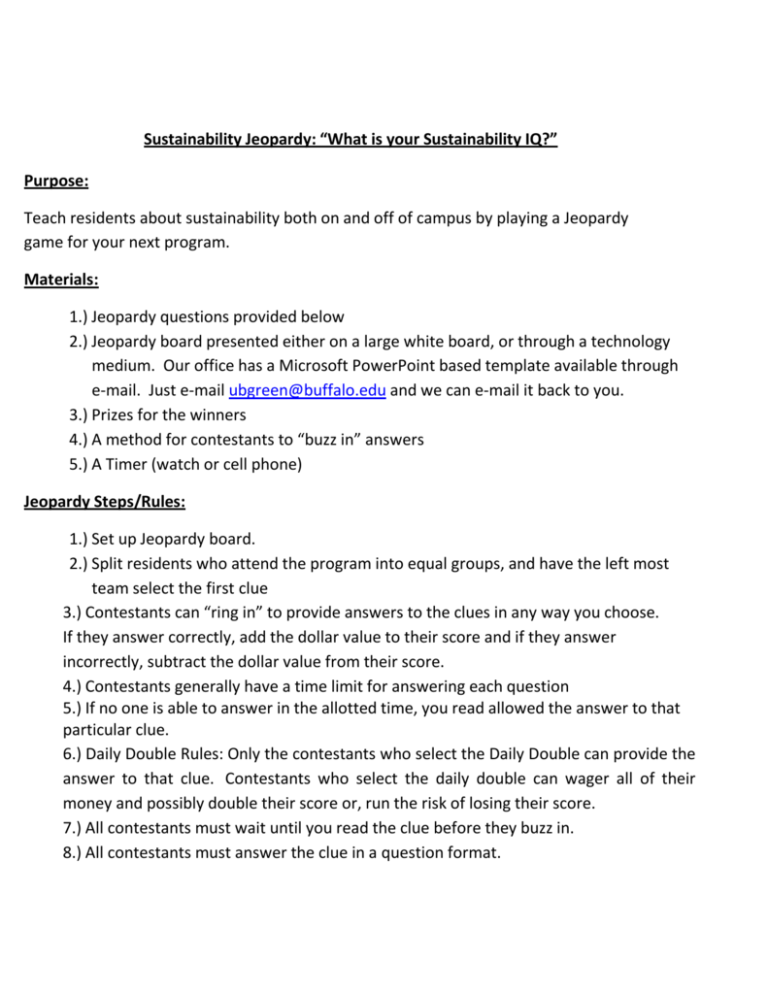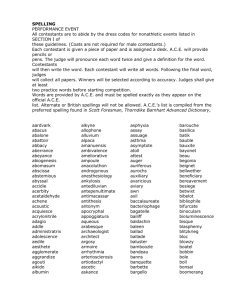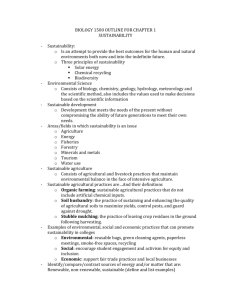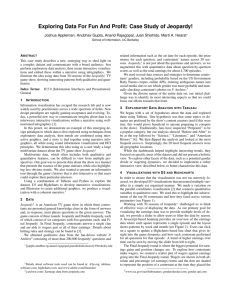Sustainability Jeopardy Part I
advertisement

Sustainability Jeopardy: “What is your Sustainability IQ?” Purpose: Teach residents about sustainability both on and off of campus by playing a Jeopardy game for your next program. Materials: 1.) Jeopardy questions provided below 2.) Jeopardy board presented either on a large white board, or through a technology medium. Our office has a Microsoft PowerPoint based template available through e-mail. Just e-mail ubgreen@buffalo.edu and we can e-mail it back to you. 3.) Prizes for the winners 4.) A method for contestants to “buzz in” answers 5.) A Timer (watch or cell phone) Jeopardy Steps/Rules: 1.) Set up Jeopardy board. 2.) Split residents who attend the program into equal groups, and have the left most team select the first clue 3.) Contestants can “ring in” to provide answers to the clues in any way you choose. If they answer correctly, add the dollar value to their score and if they answer incorrectly, subtract the dollar value from their score. 4.) Contestants generally have a time limit for answering each question 5.) If no one is able to answer in the allotted time, you read allowed the answer to that particular clue. 6.) Daily Double Rules: Only the contestants who select the Daily Double can provide the answer to that clue. Contestants who select the daily double can wager all of their money and possibly double their score or, run the risk of losing their score. 7.) All contestants must wait until you read the clue before they buzz in. 8.) All contestants must answer the clue in a question format. 9.) Contestants with the highest score after all clues have been revealed can win a prize. Time Commitment: 1-2 hour program, depending on how many residents attend, and how smoothly the game is run Budget: Budget is dependent on the prizes you want to provide, but could be as cheap as $10.00. Jeopardy Questions: Renewable Energy: 100: Q: Wind, water, solar, and biomass are examples of this type of energy A: What is renewable energy? 200: Q: A fossil fuel that is found deep below the earth’s surface and is pumped out. A: What is petroleum or oil? 300: Q: DAILY DOUBLE: The splitting is called fission, the coming together of atoms is called fusion A: What is nuclear energy? 400: Q: Uneven heating of the earth provides this source of energy A: What is Wind Energy? 500: Q: This kind of car has two engines – one is an efficient internal combustion engine, the other is an electric engine. A: What is a Hybrid Car? Eat your Greens: 100: Q: Nature's process of recycling decomposed organic materials into a rich soil A: What is Composting? 200: Q: Foods that are produced using methods that do not involve modern synthetic inputs such as synthetic pesticides and chemical fertilizers A: What is organic food? 300: Q: When food is disposed in a landfill it rots and becomes a significant source of this greenhouse gas A: What is methane? 400: Q: The process of raising livestock in confinement at high stocking density for purely economic reasons A: What is Factory Farming? 500: Q: The number one greenhouse gas that livestock produce A: What is Methane? UB Sustainability: 100: Q: UB’s transportation system that keeps 49,590,124 pounds of carbon dioxide out of our atmosphere every year A: What is the UB Stampede? 200: Q: UB’s residence hall that is Gold Star LEED certified A: What is Greiner Hall? 300: Q: An on-campus renewable energy resource that reduces the UB apartments energy by 30% A: What is the Solar Strand? 400: Q: UB’s commitment to be carbon neutral by 2030 A: What is UB’s Climate Action Plan? 500: Q: DAILY DOUBLE: Tracking system that UB uses to measure sustainability performance A: What is STARS, or what is the Sustainability Tracking Assessment and Rating System? 500: Q: DAILY DOUBLE: Tracking system that UB uses to measure sustainability performance A: What is STARS, or what is the Sustainability Tracking Assessment and Rating System? Climate Change: 100: Q: The average weather conditions of an area measured over a long period of time. A: What is Climate? 200: Q: Gases, such as carbon dioxide, methane and nitrous oxides, in Earth’s lower atmosphere, that trap heat. A: What are greenhouse gasses? 300: Q: The concentrations of greenhouse gases started to rise, around 1860, at the start of this era A: What is the Industrial Revolution? 400: Q: The type of gas that is a product of decomposition and is sometimes collected from the landfill to generate electricity A: What is methane gas? 500: Q: When scientists use ice cores to investigate what the climate of Earth was like in the past, they are looking for a relationship between temperature and_ . A: What is carbon dioxide? I recycle because… 100: Q: Three ways to decrease waste A: What is reduce, reuse, recycle? 200: Q: This material is recyclable and made of sand A: What is Glass? 300: Q: There is a limit to the amount of times that aluminum, can be recycled, true or false? A: False 400: Q: The average American person generates approximately this many pounds of trash per day A: What is 4 pounds? 500: Q: Americans throw away this many Styrofoam cups per year A: What is 25,000,000,000 (25 billion)? Renewable Energy Eat Your Greens UB Facts Climate Change I recycle because… $100 $100 $100 $100 $100 $200 $200 $200 $200 $200 $300 $300 $300 $300 $300 $400 $400 $400 $400 $400 $500 $500 $500 $500 $500








